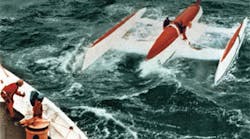Since 1982, NOAA's Search and Rescue Satellite Aided Tracking (SARSAT) System has rescued more than 28,000 people worldwide. This year alone, 102 people in the US have been rescued (as of July). In 17 different incidents, 52 people were rescued at sea. For aviation rescues, 12 people have been rescued in five incidents. The year 2011 also has seen 38 people saved in terrestrial personal-locator-beacon (PLB) rescues. NOAA-SARSAT is a part of the international Cospas- Sarsat Program of which 38 nations and two independent search-and-rescue (SAR) organizations belong (see photo). In the October 1984 issue of Microwaves & RF, an article detailed how such rescue capabilities were possible because of groundbreaking cooperation with Russia.
The Cold War was in full swing at this point in history, and it shows in the tone of the article: "In 1980, MORFLOT, the Soviet Ministry of Merchant Marine, agreed to coordinate COS-PAs, their own search and rescue satellite project, with SARSAT. In contrast to the three Western nations (the US, France, and Canada), the Soviets are self-sufficient and make their own spacecraft and hardware. Put simply,' says Fred Flatow, NASA's SARSAT mission manager, they can receive our signals and we can receive theirs, period.' Performance specifications are used to achieve compatibility, so no technology is transferred from one country to another. Since the Soviets aren't interested in enhancing the communications capability of the US military, their COSPAS satellites do not receive 243-MHz signals."
In fact, when the article was written in 1984, the system relied exclusively on Soviet satellites. The Soviets launched the system's first spacecraft, COSPAS I, in June 1982. In March 1983, two more satellites carrying SARSAT hardware were launched: SARSAT I (NOAA-8) and COSPAS II. Yet NOAA-8 failed, leading to the launch of COSPAS III.
Flatow pointed out that only the four founding nationsthe US, France, Canada, and the Soviet Unionmade policy for SARSAT/COSPAS. The article continued, "Chief among what he (Flatow) calls investigators,' or countries that participate at reduced levels of commitment, are Norway and Britain. Norway's mission control center, says Flatow, is crucial, while Britain is constructing its own 406-MHz ground stations. Other countries that have expressed interest in joining the program are Finland, which is conducting beacon experiments, and Sweden, Bulgaria, Denmark, and Brazil."
At this time, the organization was just starting to experiment with 406-MHz beacons. The system was providing satellite rescue service for aircraft equipped with emergency locator transmitters (ELTs) and ships carrying emergency position indicator radio beacons (EPIRBs). Those emitters operated at 121.5 MHz (the international distress frequency) and 243 MHz (a US military frequency). With only 75-mW output power, those elts and EPIRBs were not designed for use with a satellite system. In addition, the 121.5-MHz and 243-MHz beacons transmitted continuously for 48 hours. By contrast, the 406-MHz beacons transmitted a half-second signal once every 50 seconds. The signals of the new beacons also would carry digital identification of the craft in distress, such as the name of its owner and country of origin. Today, 406-MHz beacons are still in usewhether they are ELTs, EPIRBs, or personal locator beacons (PLBs). And each 406-MHz beacon indeed transmits a unique digital code that identifies the type of beacon, allowing registration data to be associated with the beacon.

